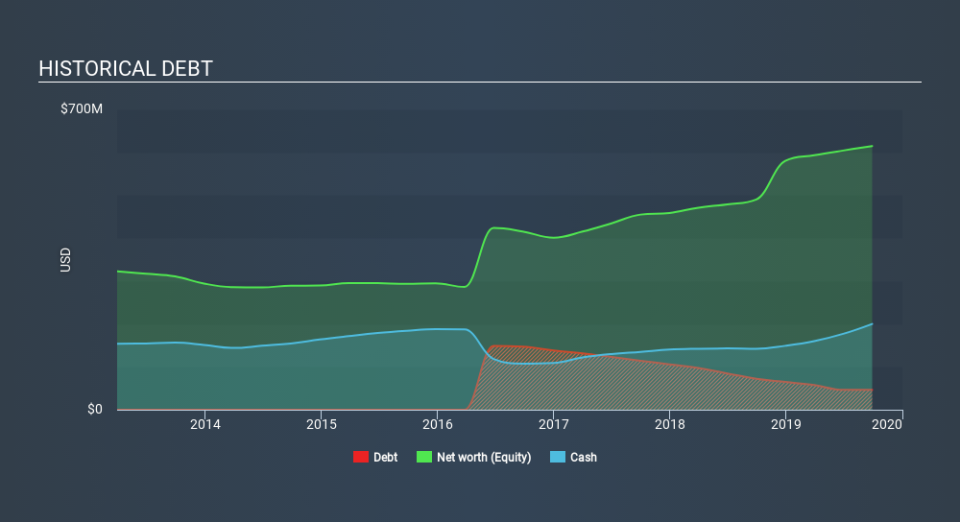Does FormFactor (NASDAQ:FORM) Have A Healthy Balance Sheet?

The external fund manager backed by Berkshire Hathaway's Charlie Munger, Li Lu, makes no bones about it when he says 'The biggest investment risk is not the volatility of prices, but whether you will suffer a permanent loss of capital. It's only natural to consider a company's balance sheet when you examine how risky it is, since debt is often involved when a business collapses. We note that FormFactor, Inc. (NASDAQ:FORM) does have debt on its balance sheet. But should shareholders be worried about its use of debt?
When Is Debt A Problem?
Generally speaking, debt only becomes a real problem when a company can't easily pay it off, either by raising capital or with its own cash flow. Ultimately, if the company can't fulfill its legal obligations to repay debt, shareholders could walk away with nothing. While that is not too common, we often do see indebted companies permanently diluting shareholders because lenders force them to raise capital at a distressed price. Of course, debt can be an important tool in businesses, particularly capital heavy businesses. When we examine debt levels, we first consider both cash and debt levels, together.
See our latest analysis for FormFactor
How Much Debt Does FormFactor Carry?
You can click the graphic below for the historical numbers, but it shows that as of September 2019 FormFactor had US$46.2m of debt, an increase on US$72.3, over one year. However, it does have US$200.0m in cash offsetting this, leading to net cash of US$153.8m.
How Healthy Is FormFactor's Balance Sheet?
According to the last reported balance sheet, FormFactor had liabilities of US$141.9m due within 12 months, and liabilities of US$37.2m due beyond 12 months. Offsetting these obligations, it had cash of US$200.0m as well as receivables valued at US$86.6m due within 12 months. So it can boast US$107.5m more liquid assets than total liabilities.
This short term liquidity is a sign that FormFactor could probably pay off its debt with ease, as its balance sheet is far from stretched. Simply put, the fact that FormFactor has more cash than debt is arguably a good indication that it can manage its debt safely.
Also positive, FormFactor grew its EBIT by 26% in the last year, and that should make it easier to pay down debt, going forward. There's no doubt that we learn most about debt from the balance sheet. But it is future earnings, more than anything, that will determine FormFactor's ability to maintain a healthy balance sheet going forward. So if you're focused on the future you can check out this free report showing analyst profit forecasts.
Finally, a company can only pay off debt with cold hard cash, not accounting profits. FormFactor may have net cash on the balance sheet, but it is still interesting to look at how well the business converts its earnings before interest and tax (EBIT) to free cash flow, because that will influence both its need for, and its capacity to manage debt. Over the last three years, FormFactor actually produced more free cash flow than EBIT. That sort of strong cash generation warms our hearts like a puppy in a bumblebee suit.
Summing up
While we empathize with investors who find debt concerning, you should keep in mind that FormFactor has net cash of US$153.8m, as well as more liquid assets than liabilities. And it impressed us with free cash flow of US$84m, being 168% of its EBIT. So we don't think FormFactor's use of debt is risky. When analysing debt levels, the balance sheet is the obvious place to start. However, not all investment risk resides within the balance sheet - far from it. For instance, we've identified 1 warning sign for FormFactor that you should be aware of.
At the end of the day, it's often better to focus on companies that are free from net debt. You can access our special list of such companies (all with a track record of profit growth). It's free.
If you spot an error that warrants correction, please contact the editor at editorial-team@simplywallst.com. This article by Simply Wall St is general in nature. It does not constitute a recommendation to buy or sell any stock, and does not take account of your objectives, or your financial situation. Simply Wall St has no position in the stocks mentioned.
We aim to bring you long-term focused research analysis driven by fundamental data. Note that our analysis may not factor in the latest price-sensitive company announcements or qualitative material. Thank you for reading.

 Yahoo Finance
Yahoo Finance 
